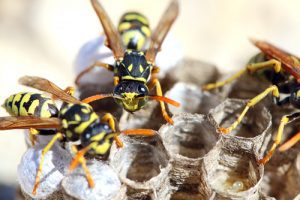Paper Wasps Are Building Their Nests Now
By Chris Williams on April 24, 2012.
Q. I’ve been seeing quite a few large, brownish wasp-like things hanging around the front porch of our house, and there’s something in the corner that looks like it could be the beginning of a nest. Do you know what these are? Will they go away on their own?
 A. If they’re brownish wasps, they are probably northern paper wasps. At this time of year, paper wasp queens are scouting, flying up and down outside walls, looking for a good nest site. A protected inside corner of a porch roof would be a typical nest site for paper wasps. Some queen wasps have already started their papery comb nests. Right now a nest may have just a few cells in it in which the queen will lay eggs. Once these eggs hatch, the new worker wasps take over rearing the young and the nest gradually increases in size as new cells are added. Compared to other wasps, paper wasp nests remain rather small with less than 100 workers.
A. If they’re brownish wasps, they are probably northern paper wasps. At this time of year, paper wasp queens are scouting, flying up and down outside walls, looking for a good nest site. A protected inside corner of a porch roof would be a typical nest site for paper wasps. Some queen wasps have already started their papery comb nests. Right now a nest may have just a few cells in it in which the queen will lay eggs. Once these eggs hatch, the new worker wasps take over rearing the young and the nest gradually increases in size as new cells are added. Compared to other wasps, paper wasp nests remain rather small with less than 100 workers.
A paper wasp nest consists of a single paper comb with exposed cells. A paper envelope does not cover the nest as it does with hornets and yellowjackets. The nest hangs from a short stalk and looks somewhat like an umbrella missing its handle, which is why paper wasps are sometimes called umbrella wasps.
Paper wasp nests are built in shaded, high, protected sites, usually under the eaves of a building, in vents, behind shutters, under window ledges, or in attics, porches, sheds, and outbuildings. They’ll also nest in outdoor equipment like gas grills, boats, swing sets, and lawn tractors.
Paper wasps have long legs and a narrow abdomen that is pointed at each end, and is connected to the thorax by a narrow “wasp waist.” Our common northern paper wasp is reddish-brown with orange or yellow markings and is about ¾ inch long. When the wasp flies, its legs tend to dangle below and behind. We also have another newly imported paper wasp called the European paper wasp. This wasp has black and yellow coloration more like a yellowjacket, and is more aggressive than the common paper wasp. The European paper wasp has the habit of nesting in hidden places, too, including inside wall voids in homes and abandoned vehicles.
Paper wasps are beneficial. They collect caterpillars and other insects to feed to their larvae. They’re more docile than yellowjackets but can sting if the nest is disturbed. Paper wasps become a problem when nests are built over doorways or in other sites where they have close contact with people. In these situations and if there are children or pets involved, you should have a pest control company remove the nest and treat the nest site to keep the wasps from rebuilding in the same place.
In late summer, nests are abandoned and fertile queens look nearby for protected overwintering sites. If they can find their way inside, paper wasps will hide inside attics or wall voids until late winter/early spring when they become active. Nests are not reused the following year, although a desirable site may be reused, with new nests being built alongside the old.